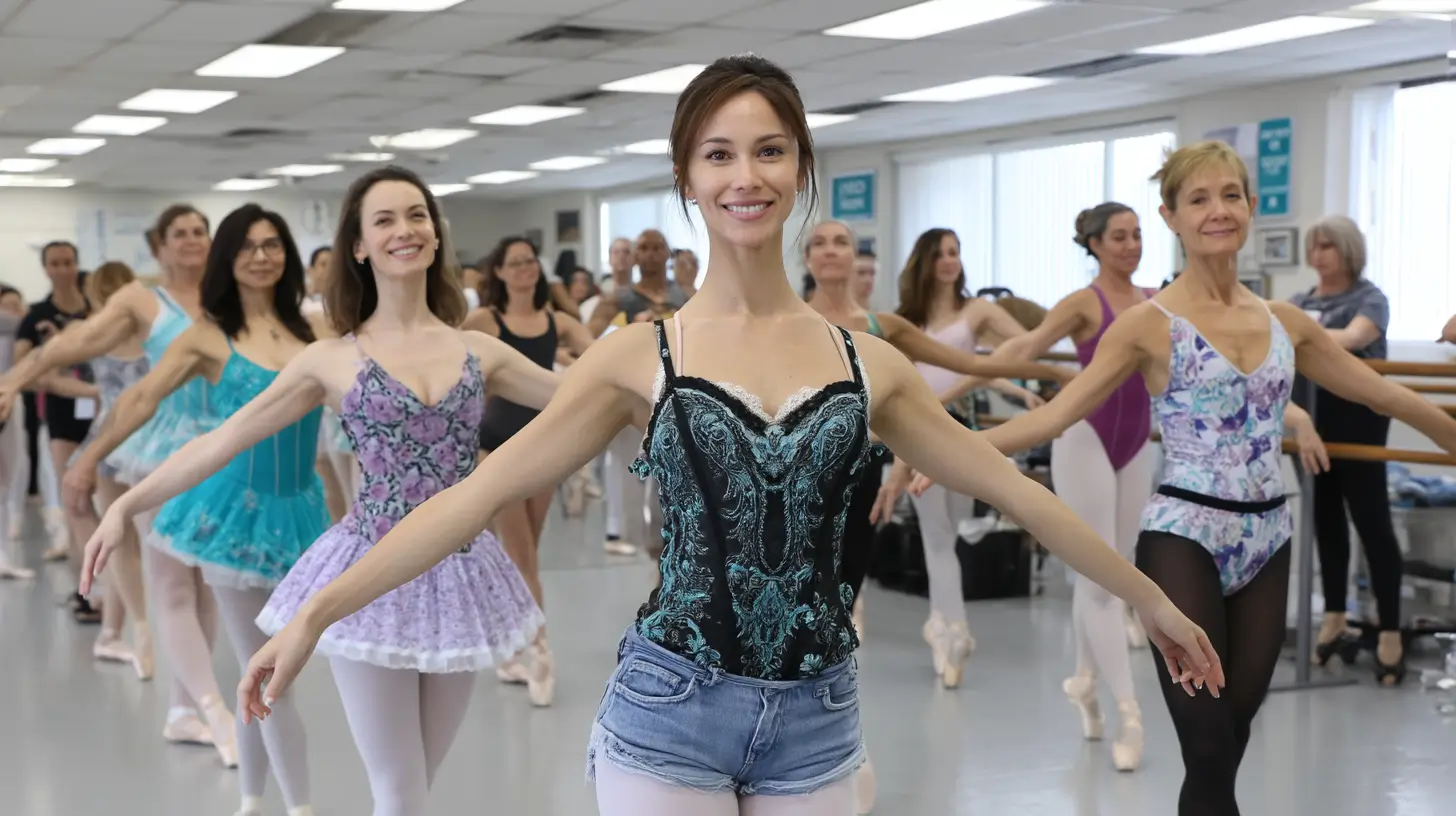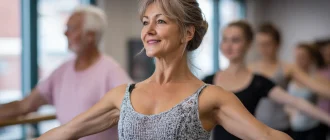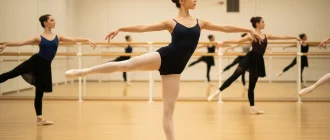Wondering why ballet is good for you? Ballet enhances your flexibility, strengthens your muscles, and boosts mental agility. In this article, we’ll dive into how ballet can improve your physical and psychological health.
Key Takeaways
- Ballet enhances flexibility, strength, and posture, promoting better body mechanics and reducing the risk of injuries.
- Engaging in ballet boosts cardiovascular health and mental agility, contributing to overall fitness and cognitive function.
- Ballet fosters emotional well-being and social connections, creating a supportive community while building confidence and mindfulness.
Art de Podcast
| # | Benefit | What the Research Shows | Representative Study (Year) | Quick Tip for Dancers |
|---|---|---|---|---|
| 1 | Total‑body strength & lean muscle | Years of ballet training reorganise muscle activation patterns, improving coordination and daily‑life functional strength. | Sawers et al., J Neurophysiol (2015) | Add slow, sustained “adage” work to lengthen while you strengthen. |
| 2 | Flexibility & range of motion | Continuous stretching in class produces longer, more pliable muscles — an advantage noted even by professional athletes who cross‑train with ballet. | Ballet Fusion blog synthesising athlete experiences (2019) | Finish class with gentle static stretches while the muscles are still warm. |
| 3 | Posture & core alignment | Motion-capture studies show that ballet drills significantly refine spinal alignment and pelvic stability, improving everyday posture. | Chen et al., Int. J. Human‑Computer Studies (2024) | Visualize a string lifting the crown of your head to keep your torso stacked. |
| 4 | Balance & proprioception | Dancers outperform non-dancers in single-leg stance and adapt more quickly to balance challenges. | Janura et al., PLOS ONE (2019) | Practise relevés on foam pads to up‑train stabilising muscles. |
| 5 | Bone density & joint support | Weight‑bearing jumps and landings raise bone mineral density, especially in the legs and pelvis, despite dancers’ low body mass. | Van Marken‑Lichtenbelt et al., Br J Nutrition (2007) | Land through the foot “toes–ball–heel” to load bones safely. |
| 6 | Cardiovascular endurance | Company dancers reach VO₂‑peak values comparable to field‑sport athletes, confirming ballet’s aerobic demand. | Wyon et al., Univ. Wolverhampton report (2024 pre‑print) | String centre‑work combinations together with minimal rest to raise the heart rate. |
| 7 | Cognitive agility & memory | Complex choreography recruits executive function, visuospatial processing, and memory, supporting neuroplasticity across the lifespan. | Hackney & Ting, BMC Neurosci (2024) | Challenge yourself to learn new sequences on the opposite side to tax the brain. |
| 8 | Mental health & stress relief | Dancing reduces rumination, boosts endorphins, and improves self‑esteem, anxiety, and depression scores. | VerywellMind synthesis of peer‑reviewed studies (2021) | Treat class as a mindful “hour off‑grid” — focus only on breath and movement. |
| 9 | Clinical neuro‑rehabilitation | The PD‑Ballet RCT is testing ballet’s ability to ease both motor and non‑motor Parkinson’s symptoms. Initial studies show promise for gait, mood, and quality of life. | Podlewska et al., BMC Compl. Med Ther. (2024) | Adapt the basic barre to chair- or support-based formats for clinical populations. |
| 10 | Social connection & community | Inclusive adult ballet programmes report soaring enrolment and strong peer support networks, countering loneliness. | Glamour feature on Washington School of Ballet (2025) | Stay for post‑class coffee or group chats to cement new friendships. |
Enhances Flexibility and Range of Motion

Ballet as a dance form significantly enhances flexibility and range of motion by focusing on stretching major muscle groups in the legs, feet, arms, back, and neck. Regular ballet exercises elongate these muscles, increasing flexibility and reducing the risk of tightness and injuries as you age.
A key component of adult ballet classes is the adult ballet barre, where dancers perform stretching and strengthening exercises for support in the ballet barre class. These exercises improve flexibility and mobility, ensuring your body remains agile and supple. Continuous practice helps maintain muscle tone and enhances the overall range of motion.
Ballet engages the entire body harmoniously, promoting lymph drainage and improving balance. Unlike other forms of physical activities that isolate muscle groups, ballet offers a comprehensive workout that benefits every part of your entire body. This holistic approach makes ballet a powerful tool for maintaining and improving flexibility.
Improves Posture and Alignment through Ballet Technique

A noticeable benefit of learning ballet is improved posture and alignment. Ballet emphasizes the alignment of the spine, pelvis, and limbs, strengthening muscles and promoting a lengthened posture, which leads to a well-aligned dancer’s body.
In ballet classes, dancers learn to identify and correct common postural problems, such as square hips, rounded shoulders, and misaligned hips. Exercises targeting these issues lead to a more balanced and aligned body for dancers. This improved posture extends beyond the dance studio, helping you move with greater ease and reducing your risk of injury.
Regular ballet practice strengthens the core and lower body muscles, which are crucial for functional movements like bending and lifting. Increased awareness of body alignment helps foster long-term improvements in posture, ensuring good posture even when you’re not dancing. The physical benefits of better posture are complemented by the confidence from standing tall and moving gracefully.
Builds Muscular Strength and Tone
Ballet training is as physically demanding as top-level sports, providing a great workout that builds muscular strength and tone. Through various movements and exercises, ballet engages the entire body, working different muscle groups to create a strong and resilient dancer’s body. This comprehensive approach leads to balanced muscle development and improved overall strength.
Adult ballet classes help develop lean muscle, making muscles stronger and more resilient against strain and injury. The diverse movements in ballet shape and tone every muscle group, from the legs and glutes to the arms and core. Unlike many other forms of strength training that may result in bulky muscles, adult ballet only creates long, lean muscle tone, enhancing both strength and flexibility. Additionally, an adult ballet class can be a great way to experience these benefits.
The benefits of ballet extend beyond muscle tone. The discipline and precision required in ballet improve balance and coordination, which in turn contribute to better overall body control. Enhanced strength and muscle tone not only make you look and feel better but also improve performance in other physical activities. Ballet strengthens muscles while promoting grace and agility.
Boosts Cardiovascular Health and Stamina

Ballet is not just about grace and elegance; it also offers significant cardiovascular benefits. Regular ballet practice improves heart health by consistently elevating the heart rate during classes. This type of aerobic exercise helps strengthen the heart and improves overall cardiovascular health and endurance.
The comprehensive nature of ballet, combining aerobic and strength elements, makes it an effective workout for boosting stamina. Engaging in various ballet movements teaches your body to perform physical activities with greater ease and efficiency, allowing you to enjoy a more active lifestyle without feeling easily fatigued.
In addition to promoting cardiovascular health, ballet helps release happy hormones, enhancing overall well-being. The physical activity involved in ballet burns calories and contributes to improved cognitive function, making it a well-rounded exercise benefiting both body and mind.
Whether you aim to improve your fitness or enjoy ballet, it requires a fun and engaging way to stay active. Ballet offers a great workout and endless physical benefits.
Increases Mental Agility and Cognitive Function
Ballet is not just a physical activity; it also offers significant mental stimulation. Memorizing routines and synchronizing movements with music promotes improved memory and attention. This mental discipline enhances cognitive functions, making ballet a powerful tool for increasing mental agility.
The complex, graceful choreography and precise movements in ballet stimulate neuroplasticity, the brain’s ability to form new connections and reorganize itself. This enhanced brain function leads to improved cognitive skills, helping you stay sharp and focused. Ballet’s mental stimulation and brain movement can be particularly beneficial as you age, keeping your mind active and brain still engaged.
In addition to cognitive benefits, ballet fosters improved mental well-being. The discipline and concentration required in ballet help develop skills transferable to other areas of everyday life. Whether it’s enhanced problem-solving skills, improved cognitive function, or better time management, the mental benefits of ballet extend beyond the dance studio.
Promotes Emotional Well-being and Self-Confidence

Ballet promotes emotional well-being and boosts self-confidence. Engaging in dance releases endorphins, also known as “happy hormones,” which lower stress levels and enhance feelings of happiness and well-being. This emotional uplift can significantly improve your overall mental health.
Participating in ballet alleviates stress by providing a creative outlet for self-expression. The beautiful music and graceful choreography create a soothing environment that fosters emotional well-being and builds self-confidence. Additionally, the supportive atmosphere of ballet classes encourages trying new things and overcoming challenges, leading to a sense of accomplishment and increased self-confidence.
Positive feedback and achievements in ballet, as well as taking dance classes, contribute to increased self-esteem. Ballet promotes happier relationships and social skills, making it a valuable activity for enhancing mental and emotional well-being.
Enhances Coordination and Balance
Ballet training significantly enhances coordination and balance. It requires managing multiple physical tasks simultaneously, improving overall coordination. Regular practice teaches ballet dancers how to make precise adjustments to their body position, enhancing balance and control.
Emphasis on body alignment and movement control in ballet training leads to better hand-eye coordination and overall balance. These skills benefit not only dancing but also many other forms of physical activities, reducing the risk of falls and improving agility in everyday tasks.
Ballet increases awareness of your physical movements, contributing to better balance and stability. Enhanced coordination and balance benefit various aspects of everyday life, from sports to daily activities. Ballet training improves how you move and carry yourself, both on and off the dance floor.
Social Benefits and Community Building
Participating in ballet classes offers significant social benefits and fosters a sense of community. Ballet classes provide opportunities to meet others with similar interests, creating lasting friendships and a supportive network. This sense of community enhances emotional well-being and makes learning ballet more enjoyable.
Social skills developed in ballet classes, such as making and maintaining eye contact and working collaboratively with others, translate to daily life. Interpersonal connections formed in ballet classes contribute to the overall happiness and satisfaction that ballet brings, making it a social activity for both other dancers and ballet dancers.
Supports Bone Health and Reduces Injury Risk
Ballet supports bone health as a weight-bearing exercise that helps enhance muscle strength and promote bone density. Achieving peak bone mass in your late teens to early twenties is crucial for long-term bone strength. Ballet enables you to reach and maintain this peak, reducing the risk of osteoporosis and other bone-related issues as you age.
Incorporating ballet into your routine can minimize injury risk by promoting an active lifestyle and improving spinal health. Proper nutrition, including key nutrients such as calcium and vitamin D, is crucial for maintaining bone health. Ballet training often includes guidance on maintaining a balanced diet.
Ballet technique offers a holistic approach to maintaining and improving bone health.
Encourages Mindfulness and Stress Relief

Ballet fosters mindfulness by requiring full concentration on movements and the music’s rhythm, leading to improved focus and attention. This mindfulness acts as a form of meditation, enhancing mental clarity and reducing symptoms of anxiety and depression.
The structured nature of ballet provides a dedicated time to focus on the present, crucial for stress relief. The enjoyment and creative expression found in ballet, which takes form in dancing to beautiful music, further contributes to lower stress levels and emotional well-being among other dancers.
Ballet promotes physical health and nurtures a peaceful, focused mind.
Performance Opportunities

Ballet offers ballet dancers a wealth of performance opportunities that can significantly enhance a dancer’s experience and growth. These opportunities not only allow ballet dancers to showcase their skills but also contribute to their physical benefits, self-confidence, and mental well-being.
Resume
In summary, ballet offers a multitude of benefits that go beyond physical fitness. From enhancing flexibility, strength, and cardiovascular health to improving mental agility, emotional well-being, and social connections, ballet is a comprehensive activity that enriches your daily life in many ways. Whether you’re looking to improve your posture, boost your confidence, or enjoy a fun and engaging form of exercise, ballet is a wonderful way to achieve these goals. Leap and discover the transformative power and benefits of ballet now.
Frequently Asked Questions
Is ballet only for young people?
Ballet is for everyone, regardless of age! With classes tailored for all skill levels, regardless of age, you can join in and enjoy the many benefits ballet brings to your physical and mental well-being.
Can ballet help with weight loss?
Ballet can be an excellent way to lose weight as it combines aerobic exercise with strength training, helping you burn more calories while improving your overall fitness. Embrace the grace of ballet, and watch your goals become a reality!
Do I need any prior dance experience to start ballet?
Not! You can start learning ballet even if you’re a complete beginner, and classes are designed to help you build the fundamentals while improving your strength and flexibility. Embrace the journey!
How often should I practice ballet to see benefits?
To see real benefits in ballet, practice consistently a few times a week. Regular training will boost your flexibility, strength, and posture!
Can ballet help with mental health issues?
Ballet can significantly boost your mental health by reducing stress and enhancing your mood through the joy of movement and mindfulness. Embrace this beautiful art form to uplift your spirits!







